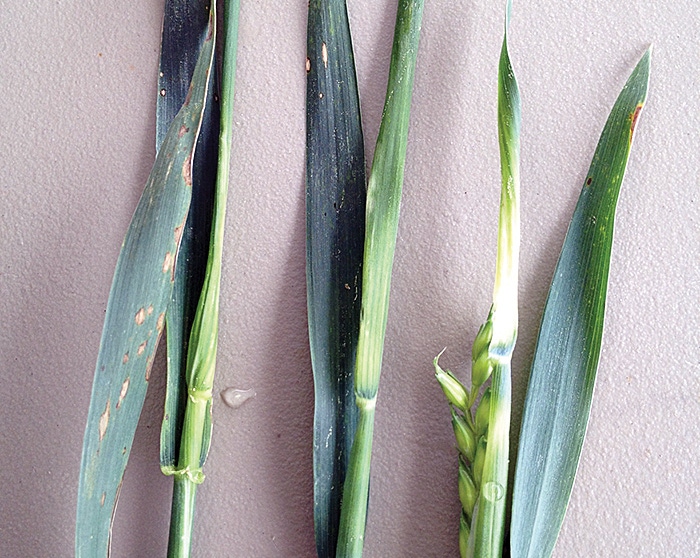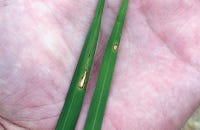April 17, 2015

Burndown and planting is in full swing in southeast Arkansas as I am writing this article. We are still pretty wet, however, in some areas up north. When we are anxious to plant, we tend to take risks. Watch out for wheat fields and other sensitive areas while trying to make last minute burn-down and pre applications. In particular, be aware that at this time of year, wheat is extremely sensitive to Roundup drift.
According to Jason Kelley, Extension wheat specialist, we have 350,000 acres of wheat in Arkansas this spring. By now it is all past the window for 2,4-D applications, leaving only Harmony Extra as an option for broadleaf control. These acres are scattered all over and mixed in with other production fields that need to be sprayed.

Gramoxone drift to wheat (click to enlarge)
It is too late for 2,4-D because the wheat has moved past the tillering stage into the reproductive stage or joint elongation. At this stage you can cut open a stem of wheat, just like rice, and find the developing seedhead. Many herbicides are translocated to the point of most active cell division, in this case where the heads are being formed. This is the case for both 2,4-D and glyphosate.
Exposing wheat to either 2,4-D or glyphosate after joint elongation can affect reproduction and reduce yields. In the case of 2,4-D, it can cause seedheads to fail to emerge from the top of the sheath and come out the sides instead. It may reduce seed production and lower test weights, but may not completely eliminate yield.
Roundup or glyphosate drift can cause symptoms similar to cause by 2,4-D. One difference is often a pronounced bleaching or yellowing where the flag leaf attaches to the stem. Another is short flag leaves. The top of the leaf collar can become pinched, not allowing the seedheads, which are often blank, to emerge at all.
In addition, Gramoxone drift on wheat is pretty common this time of the year. Until last year I had never seen Gramoxone or paraquat drift impact yield. Most of the time it is a tattle tale — small spots that resemble and are often mistaken for disease show up as a result of Gramoxone drift. However, this herbicide is not translocated like Roundup, and the injury is localized in a spot.
Even when several spots hit a flag leaf, the impact on yield that I have observed has always been negligible. However, I did see at least a couple of fields last summer where Gramoxone ended up on some heading rice and physically damaged the seeds in the heads, blanking a few individual seeds. That probably could also happen to wheat later in the spring.
Many people call me asking when it is safe to drift on wheat. My answer is always the same — after it is harvested.
My wheat work is made possible through a grant from the Arkansas Wheat Promotion Board and I greatly appreciate their continued support.
You May Also Like




